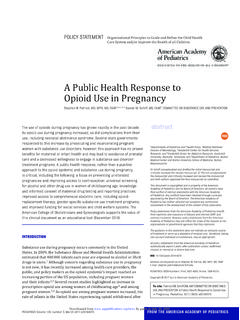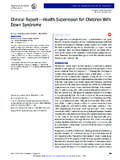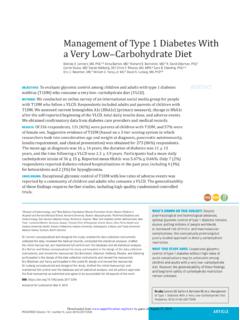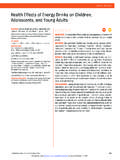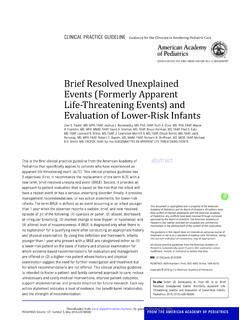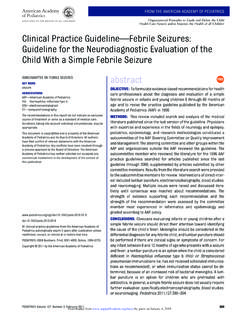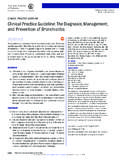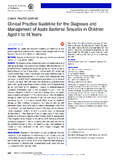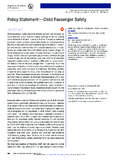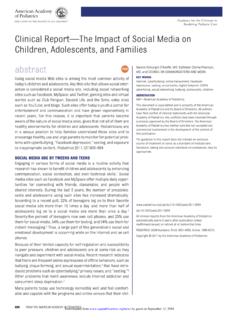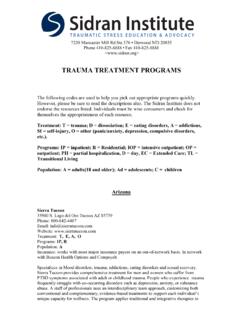Transcription of CLINICAL PRACTICE GUIDELINE ADHD: Clinical Practice ...
1 FROM THE AMERICAN ACADEMY OF PEDIATRICS. Guidance for the Clinician in Rendering Pediatric Care CLINICAL PRACTICE GUIDELINE . ADHD: CLINICAL PRACTICE GUIDELINE for the Diagnosis, Evaluation, and Treatment of Attention-De cit/. Hyperactivity Disorder in Children and Adolescents SUBCOMMITTEE ON ATTENTION-DEFICIT/HYPERACTIVITY. DISORDER, STEERING COMMITTEE ON QUALITY. IMPROVEMENT AND MANAGEMENT. abstract +. KEY WORDS. Attention-de cit/hyperactivity disorder (ADHD) is the most common attention-de cit/hyperactivity disorder, children, adolescents, neurobehavioral disorder of childhood and can profoundly affect the preschool, behavioral therapy, medication academic achievement, well-being, and social interactions of children.
2 ABBREVIATIONS the American Academy of Pediatrics rst published CLINICAL recommen- AAP American Academy of Pediatrics ADHD attention-de cit/hyperactivity disorder dations for the diagnosis and evaluation of ADHD in children in 2000;. DSM-PC Diagnostic and Statistical Manual for Primary Care recommendations for treatment followed in 2001. Pediatrics 2011;128: CDC Centers for Disease Control and Prevention 1007 1022. FDA Food and Drug Administration DSM-IV Diagnostic and Statistical Manual of Mental disorders , Fourth Edition MTA Multimodal Therapy of ADHD Summary of key action statements: This document is copyrighted and is property of the American 1.
3 The primary care clinician should initiate an evaluation for ADHD for Academy of Pediatrics and its Board of Directors. All authors any child 4 through 18 years of age who presents with academic or have led con ict of interest statements with the American Academy of Pediatrics. Any con icts have been resolved through behavioral problems and symptoms of inattention, hyperactivity, or a process approved by the Board of Directors. The American impulsivity (quality of evidence B/strong recommendation). Academy of Pediatrics has neither solicited nor accepted any commercial involvement in the development of the content of 2.
4 To make a diagnosis of ADHD, the primary care clinician should this publication. determine that Diagnostic and Statistical Manual of Mental Disor- The recommendations in this report do not indicate an exclusive ders, Fourth Edition criteria have been met (including documenta- course of treatment or serve as a standard of medical care. tion of impairment in more than 1 major setting); information Variations, taking into account individual circumstances, may be appropriate. should be obtained primarily from reports from parents or guard- ians, teachers, and other school and mental health clinicians in- volved in the child's care.
5 The primary care clinician should also rule out any alternative cause (quality of evidence B/strong recommendation). 3. In the evaluation of a child for ADHD, the primary care clinician should include assessment for other conditions that might coexist with ADHD, including emotional or behavioral (eg, anxiety, depres- sive, oppositional de ant, and conduct disorders ), developmental (eg, learning and language disorders or other neurodevelopmental disorders ), and physical (eg, tics, sleep apnea) conditions (quality of evidence B/strong recommendation).
6 All CLINICAL PRACTICE guidelines from the American Academy of Pediatrics automatically expire 5 years after publication unless 4. The primary care clinician should recognize ADHD as a chronic reaf rmed, revised, or retired at or before that time. condition and, therefore, consider children and adolescents PEDIATRICS (ISSN Numbers: Print, 0031-4005; Online, 1098-4275). with ADHD as children and youth with special health care needs. Copyright 2011 by the American Academy of Pediatrics Management of children and youth with special health care needs should follow the principles of the chronic care model and the medical home (quality of evidence B/strong recommendation).
7 PEDIATRICS Volume 128, Number 5, November 2011 from by guest on October 2, 2019 1007. Downloaded 5. Recommendations for treatment of should prescribe Food and dren 6 through 12 years of age. There children and youth with ADHD vary Drug Administration approved is now emerging evidence to expand depending on the patient's age: medications for ADHD with the the age range of the recommendations a. For preschool-aged children assent of the adolescent (qual- to include preschool-aged children (4 5 years of age), the primary ity of evidence A/strong recom- and adolescents.)
8 This GUIDELINE ad- care clinician should prescribe mendation) and may prescribe dresses the diagnosis and treatment evidence-based parent- and/or behavior therapy as treatment of ADHD in children 4 through 18 years teacher-administered behavior for ADHD (quality of evidence of age, and attention is brought to spe- therapy as the rst line of treat- C/recommendation), preferably cial circumstances or concerns in par- ment (quality of evidence both. ticular age groups when appropriate. A/strong recommendation) and 6.
9 The primary care clinician should Expanded Scope may prescribe methylphenidate titrate doses of medication for if the behavior interventions do ADHD to achieve maximum bene t Behavioral interventions might help not provide signi cant improve- with minimum adverse effects families of children with hyperactive/. ment and there is moderate-to- (quality of evidence B/strong impulsive behaviors that do not meet severe continuing disturbance recommendation). full diagnostic criteria for ADHD. Guid- in the child's function.
10 In areas ance regarding the diagnosis of where evidence-based behav- INTRODUCTION problem-level concerns in children ioral treatments are not avail- based on the Diagnostic and Statisti- This document updates and replaces 2. able, the clinician needs to cal Manual for Primary Care (DSM-PC), previously published CLINICAL guide- weigh the risks of starting med- Child and Adolescent Version,3 as well lines from the American Academy of ication at an early age against as suggestions for treatment and care Pediatrics (AAP) on the diagnosis and of children and families with problem- the harm of delaying diagnosis treatment of attention-de cit/hyperac- and treatment (quality of evi- level concerns, are provided here.)
